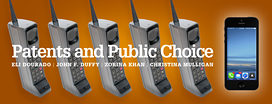To take this conversation down a somewhat tangential path, it might be interesting to explore the question of how we should choose to define a software patent. A few years ago, in an amicus brief[1] for the Cato Institute, Reason Foundation, and Competitive Enterprise Institute, I and others proposed the following as a definition of software and processes not eligible for patent protection:
The term “process” in section 101 is properly limited to processes which aim to have an effect on matter. Although software and business method patents have proliferated over the past two decades, many software and business-method patents . . . should not qualify as patentable subject matter because the purpose of performing the processes is not to have an effect on the physical world.
Prior Supreme Court precedent is consistent with this historic understanding of patentable process. The aim of the [Diamond v.] Diehr patent was to cure synthetic rubber — to effect a physical change in the world — and that patent was upheld. See [450 U.S. 175, 177 (1981)]. In contrast the purpose of the [Gottschalk v.] Benson patent was to represent a number in binary, [409 U.S. 63, 64 (1972)], and the purpose of the [Parker v.] Flook patent was to calculate updated alarm limits, [437 U.S. 584, 585 (1978)]. Although the algorithms in Benson and Flook would happen to effect a change on a computer, these changes did not transform the claimed algorithms into patentable processes because the purpose of performing the claimed processes was not to alter the physical world. The aim of the Benson and Flook patents was to represent or calculate a number, respectively. Those patents were correctly invalidated.[2]
The reason for limiting patent-eligible processes to those “which aim to have an effect on matter” — as opposed to those which incidentally do (as any math requiring a pencil and paper would have an incidental effect on the paper and pencil tip) — comes from the historical understanding of “art” (the previous, and supposedly equivalent term, for “process” in 35 U.S.C. § 101).[3]
An early authority on patent law, George Ticknor Curtis, described the term “art” as “a new process or method of working or of producing an effect or result in matter.” George Ticknor Curtis, A Treatise on the Law of Patents for Useful Inventions § 9 (Boston, Little, Brown & Co. 3d ed. 1867) []. He illustrated the definition with examples drawn from case law, each of which referred to improved manufacturing techniques involving physical objects. See id. §§ 9-19. A later treatise by William Robinson defined “art” as “an act or a series of acts performed by some physical agent upon some physical object, and producing in such object some change either of character or of condition.” 1 William C. Robinson, The Law of Patents for Useful Inventions § 159 (Boston, Little, Brown & Co. 1890).[4]
There are, of course, other good ways to identify and define problematic patents. As my previous essay noted, a variety of measures would help improve the patent system, because the system has many problems that interact with and compound each other. To provide one additional solution, Mark Lemley has gotten enormous traction arguing for the elimination of “functional claiming” in software patents[5]— i.e. the practice of effectively claiming any invention that solves a problem, rather than the particular solution that has actually been invented.
The challenge behind a call to end software patents, or any type of problematic patent, is to clearly articulate the kind of patents that ought to be eliminated. Currently, we are seeing some software patents being invalidated after the Alice Corp. v. CLS Bank decision.[6] Is Alice enough? Do we need a more clearly articulated rule? What should it be? And, to return to Eli’s initial discussion, I am curious to what degree the development of better law would allay concerns about the Federal Circuit and patent bar being “captured”?
[1] Brief for the Cato Institute, Reason Foundation, and Competitive Enterprise Institute as Amici Curiae Supporting the Petitioners, Mayo Collaborative Servs. v. Prometheus Labs., 132 S.Ct. 1289 (2012) (No. 10-1150), available at http://object.cato.org/sites/cato.org/files/pubs/pdf/Mayo-brief.pdf.
[2] Id. at 12-13.
[3] The report of the Senate Judiciary Committee explained the change from “art” to “process” was cosmetic and did not alter the scope of patentable subject matter. “‘Art’ [in prior patent statutes] . . . is interpreted by the courts to be practically synonymous with process or method. The word ‘process’ has been used to avoid the necessity of explanation that the word ‘art’ as used in this place means ‘process or method,’ and that it does not mean the same thing as the word ‘art’ in other places [e.g., sections describing ‘prior art’].” S.Rep. No. 82-1979, at 2398-99 (1952).
[4] Brief for the Cato Institute, supra, at 7-8.
[5] See, e.g., Mark Lemley, Let’s Go Back to Patenting the ‘Solution,’ Not the Problem, Wired Mag., Oct. 31, 2012, http://www.wired.com/2012/10/mark-lemley-functional-claiming/; Mark Lemley, Software Patents and the Return of Functional Claiming, 2013 Wis. L. Rev. 905 (2013), available at http://ssrn.com/abstract=2117302.
[6] Timothy B. Lee, Software patents are crumbling, thanks to the Supreme Court, Vox, Sept. 12, 2014, http://www.vox.com/2014/9/12/6138483/software-patents-are-crumbling-tha….

